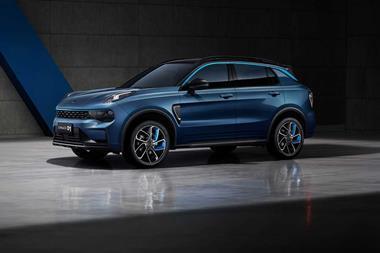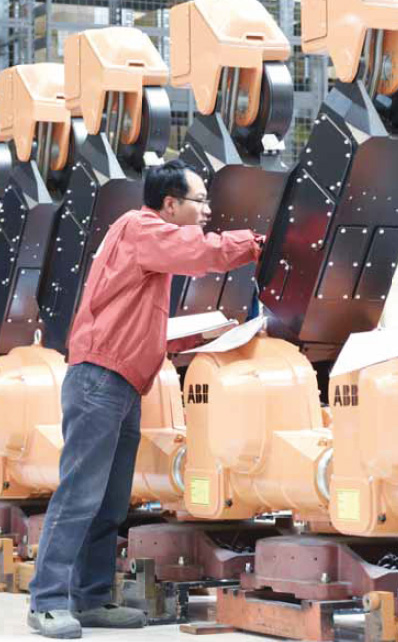
ABB group vice-president Michael Larsson discusses the technologies currently being delivered to OEMs in order to improve quality, efficiency and product throughput.
In his role as group vice-president for ABB, Larsson presides over a number different areas, powertrain automation, body-in-white and paint process automation – commonly referred to as robot systems – within the discrete automation division. Here, he outlines what these different divisions can offer carmakers in terms of process improvement, starting off with how technology delivered by ABB can improve overall engine efficiency.
Michael Larsson told AMS: A modern internal combustion engine is about 20% efficient in terms of the energy usage. Robotics can, through various processes help improve part tolerances, which helps to make a more efficient engine. [ABB] works upstream from the end user to provide equipment like part washers and cells with vision and force control.
AMS: Can you offer more details about the equipment you’re providing to do that?
ML: As an example we can talk about our industrial washers: a booth will feature a robot equipped with high-pressure nozzles to clean blocks, cranks, pistons and other engine and transmission parts. We use pure water to clean the parts without solvents or detergents, making for a very environmentally friendly solution. The installation cleans and deburrs as it goes through the process. Other things we do [include] providing sealing equipment. This used to be done by hand or with low-end automation, but now robots equipped with vision systems can ensure that engine components are joined with the right amount of sealant in any complex pattern, eliminating quality-issues that will affect the product later in the field.
AMS: Can you give an example where a recommendation from an end user has been incorporated into ABB equipment?
ML: One of the companies we work with in the United States is Ford. We work extensively with the advanced manufacturing arm to develop improved manufacturing processes for engine production. It’s an opportunity to bring in a culture of improved quality, particularly in the emerging markets. There are certain things you can take advantage of in low-cost markets where you have a manpower-versusautomation issue. What we do there is work upstream with the OEM to make sure that the applications take full advantage of the workforce and the opportunities for automation.
AMS: OEMs in India have said that equipment providers don’t offer sufficient in-country support. Does ABB offer this support for its customers, in India and elsewhere? ML: We are a company with a global footprint and this is a big advantage. A lot of our focus has been centered around the BRIC markets and we have an on-the-ground presence in all regions to offer service and local engineering. The challenge is how to make the most of low-cost labour and still deliver Western levels of quality, safety and through-put – not only in engine production but also in paint and body.
AMS: How do you do that?
ML: The experience of transplant OEMs operating in India is sometimes still shallow. They may have two or three plants in these countries, but they’re still largely producing in the West. So we work with the OEM, to say ‘based on our experience these are the areas you should really invest in to make sure the quality level is where you need to be’ and ‘here is where you can take advantage of the local suppliers and local labour costs’. That’s back and forth and it’s very interesting for us as it gives us the opportunity to let our technology continue to evolve.
AMS: How can you convince companies such as Proton, which has decided to save money by not fitting otherwise standard safety features such as airbags (for cars sold in Malaysia) to invest in comparatively expensive technology from ABB, despite the potential quality gains?
ML: Proton is an interesting case. Malaysia have had very high import duties protecting their automotive market for some time. The quality is okay as it meets the expectations and the regulations of the local market, but they’ve not had much success outside [Malaysia]. They are content providing vehicles that meet domestic expectations. But if Proton were to start exporting, on a larger scale, they will find themselves in the same position as Japanese carmakers did 30 years ago where customer expectations in markets other than the domestic are very different. This may require them to re-think their manufacturing strategy which could lead to additional automation.
Another cultural difference is attention to detail with regards to safety. An interesting aspect is that if you compare say, an emerging market OEM with a JV – maybe Ford,VW, BMW or Daimler – the Western companies tend to implement the same strict safety standards as they have in their home markets. The local OEM sees this investment and asks ‘Why? We’ve done it like this for many years and it’s oka if the guy puts his hand in there’. You can take advantage of low-cost labour, but you can never trade that off against safety.
One should note though that improvements such as safety posters, signs and training are coming very quickly. That said, I’ve seen people crawl under a robot as it’s still energized. Our job is to provide equipment that guarantees a safe working environment and use our experience to participate in bringing in higher safety standards.
AMS: This is an interesting topic, how do you make robots and humans work together safely?
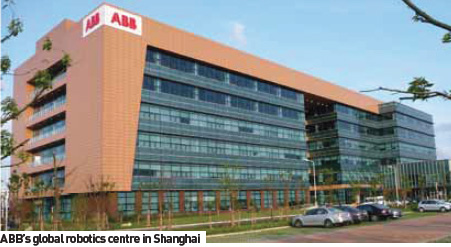
ML: Traditionally, the assembly line was all manual. Now, there’s few people on a spot welding line except for an operator loading parts. I believe that we will see more human-to-robot interaction in future manufacturing processes. We have a product called Safe-Move which is basically a vision- and sensing-driven concept where the operator can hand parts off directly to the robot and then they’re taken to the line. The traditional safety-fence is replaced, creating an opportunity for more interaction. This is a step forward, particularly in labor-intensive processes like trim and final assembly.
AMS: This goes beyond the theory of breaking the cell down into areas that become dangerous and safe as the robot moves? You’re talking about the robot having a vision system which tracks the position of the worker in real time so the robot can respond to that?
ML: Yes, in the solution we continuously scan the surface of the cell. If the worker is, let’s say, 20 feet away from the robot, it moves at normal speed. Within 10 feet the robot moves at half-speed and any closer the robot can slow down or stop completely. This allows the worker to safely interact directly with the robot.
This is a potential gain for logistics within the plant. This technology can improve [logistics] efficiency. Instead of a conveyor, where you have to wait for parts to circulate to where they’re needed, you can have a direct feed to the line.
AMS: Take that to its next step. Are we talking about a situation where robots unload trucks at the dock, other robots move those items to the line and the robots on the line position and complete the process?
ML: You can only do so much to reduce such things as cents-per-spot-weld. I think plant logistics is certainly an opportunity for automation. Today engine-assembly, weld and paint processes are completed with a very high degree of automation. An area where there is still room for further automation but has challenges with human-machine interaction is in final assembly.
To address this specific, many robot-suppliers are working on the development of advances in robotics equipment with two arms with advanced sensing equipment.
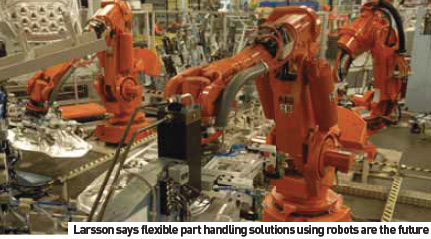
AMS: Going back to China, India and Malaysia, chow will global standardization affect BRICs and developing countries. Are they going to have to be brought up to a Western level of automation, or is there something more to that? ML: There are some differences between purely domestic OEMs and global OEMs forming JVs. Domestic OEMs in developing countries are many times pre-dominantly plantdriven, they see limited benefits of standardization. They’ll add equipment as they need to produce more cars. If you put that same company in a JV with a global OEM, the global JV partner will try to maximize process and equipment efficiencies by implementing the same solutions as they have in Europe or North America. The global OEM is looking to make all plants across the globe look the same, no matter where the plant is located, and there are very compelling reasons for this in terms of capex, risk-mitigation and overall launch efficiency. I think the major difference is how you look at your investment returns. The foreign OEM comes to China and wants to put in a $40 million (€30.1 million) manufacturing line like those in Europe. It’s completely safe, high-yielding and it delivers top quality. Then the JV partner says ‘but I bought a line last year for $8 million and it works fine’. Our role, many times, becomes the party that has to combine the different needs an find a solution that fits ‘the shoe’. I’m a believer in global standards and we are very focused on this internally, but I also live the reality where you have different electrical standards, metric versus imperial measurements, drawing standards etc. There are a lot of complexities.
AMS: Are national manufacturers standing in the way of true globalization. Companies such as Mahindra in India, Geely in China and again, Proton – they don’t want or need to conform. Is that a problem?
ML: No, I would not say that. There needs to be an up-front investment in creating the standards but there are significant long-term benefits. In low-cost markets the local partner works to ensure that automation doesn’t take place for automation’s sake and that vehicles can meet domestic market prices. Standards or not, our job is to be the manufacturing partner of choice. With our domain-expertise in manufacturing automation we have the ability to provide value by looking beyond the equipment that we deliver and work as a manufacturing consultant, providing flexible manufacturing solutions. We can define areas where automation makes sense and it’s okay to have some areas where there’s less automation. This can result in a production process that delivers a car that Europeans will buy, but without a significant increase in production costs.
AMS: Do you have any potential customers that say they would prefer to get five years productivity out of a line made up of reconditioned robots rather than ten years out of a line using new equipment, considering the upfront cost savings?
ML: Very much so. We have refurbishment programs that make pre-owned robots as good as new. This is a great way to extend the life of a robot. After the robots have been thoroughly upgraded we guarantee the working life for a certain time period. But the reconditioning discussion goes beyond only the robot. We had a very interesting situation with one OEM concerning cylinder head assembly. They said: ‘If we need to refurbish the cylinder head line, why will it cost up to 80% of the original investment? This does not make much sense. What can we do in terms of automation and tooling to reduce that?’ So by working together we developed a robotized solution which is flexible in terms of handling different products and part styles and significantly reduces refurbishment costs compared to traditional hardautomation solutions. There is still quite a lot of capital sitting on the sidelines, as production volumes came down in 2008 and 2009, so this is an important area to focus on.
AMS: More carmakers are taking responsibility for the choreography of their robotics. Are you seeing that at all? ML: This goes back and forth with many companies. Some companies make the case that they can automate better themselves – a case of having available engineers, so why pay for someone else to do this. I’ve seen OEMs take all process automation in-house and two or three years later they put it back out on the street as a result of a lack of required expertise or sufficient manpower. If you look at the complete value chain, it may actually cost more to keep this in-house.
AMS: How’s business with Tier suppliers?
ML: We have a very healthy business with Tier suppliers. The ones that survived became bigger. A few years ago there were a number of companies that lived from program to program and that’s a very difficult environment to work in. In that case, the commercial discussions quickly boil down to one thing, price. You have to give them the competitive advantage in the price war of winning contracts. Today it’s better, as dealing with Tier suppliers is more like dealing with OEMs. They’re bigger, so you know that they’re going to survive to take on the next program which creates opportunities for partnership.
AMS: Do you think that some of the ingenuity that ABB has to offer is being missed through companies looking at the bottom line, the final cost, and deciding they can’t afford that and opting for the ‘value’ package?
ML: I’m obviously not impartial, but I think that’s an issue. It’s a conservative industry, so there’s always the question of: ‘Why automate? Why use a robot? Why can’t I use manpower to complete the process?’ Increased automation comes with additional costs of operator training, different skill sets, maybe a higher degree of dependency on suppliers etc. But this is where the rubber meets the road for us and I personally enjoy working with my team creating new and creative solutions every day trying to bridge the gap. There’s also the health and safety factor. There are still paintshops where the operator with the spray gun has a paper dust mask over his face. This should of course be completely removed as you cannot put a price on human health. Beyond that, the car coming off the line is obviously not going to look the same as the last one. The need to automate is; a)where there are hazardous working conditions; b) where you need to have consistent quality; and c) where you see a need for increased productivity.
AMS: It’s also the idea of flexibility, as the robot can replace not two guys but six guys in a cell, and over three shifts that’s 18 employee wages you’re not paying.
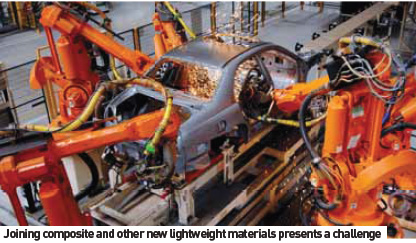 ML: Exactly. The case for robot automation can be very compelling. AMS: Do you have any new solutions for body-in-white production?
ML: Exactly. The case for robot automation can be very compelling. AMS: Do you have any new solutions for body-in-white production?
ML: A great deal of activity in the field of alternative body materials! A great example is the BMW i3 and i8. Our challenge is to supply joining solutions for composites, plastics, aluminum, rubber and glass. How do we transform our technology over from cars that were spot-welded to being screwed or glued together, using heat, laser welding, riveting etc. Specifically in the light of the need for lighter vehicles I think it will be an important issue for the next five to 10 years. What areas of the car body will go composite – replacing what was traditionally aluminum or steel – and what joining solutions will be required?
AMS: Do you have a dedicated rivet solution for joining aluminum? ML: We have worked with several OEMs to find alternatives to spot-welding. Porsche is a good example of an OEM at the forefront, looking to use different methods of joining such as screwing.
AMS: How are the joining elements, the rivets and screws, fed to the head?
ML: It could be a magazine-type solution. But beyond the challenge of the robot solution, the challenge lies in the strength of the joint; the difference between a spot-weld and a rivet and the consequences does this has further down the assembly-process in terms of geometry, body strength etc.
AMS: What can ABB provide to help OEMs produce electric vehicles? ML: We invested quite early in finding manufacturing processes around battery assembly. The battery manufacturers’ focus is more towards finding the right chemical solutions to improve battery life and making the technology safe and easy to use. We help out with the assembly process to ensure it is as efficient as possible. This is an exciting technology and we see this as an opportunity to apply our skills acquired in traditional automotive assembly to this new market space
AMS: What technologies is ABB putting forward for development of the EV market? Can you tie that in to what ABB is providing to current and future EV manufacturers?
ML: There are two streams really, one within my area of responsibility and the other within another part of the discrete automation division. In my business, we focus on the challenge of battery manufacturing using robot technology. In the other stream, ABB is providing technology for charging stations. This is more targeted towards infrastructure investments to enable cities to place charging stations at shopping malls, offices, sports arenas and in homes. AMS: How’s the adoption rate on that?
ML: We see a lot of interest in our solutions for charging stations and I think we very well positioned to compete effectively in this market. If you think about it in a larger perspective, this can lead to significant changes in how households and communities get access to cost-efficient power. We’re looking at a situation where the EV can supply stored electricity back to the household at peak times, and recharge at off-peak times.
AMS: What do you see as the next innovation in automotive production?
ML: [If we take paint] traditionally it is applied with robots using different types of application equipment or spraying paint onto the car body. An interesting question could be whether this will continue or will paint become an integral part of the body panels? A lot of focus for the last few years has been around color matching [between metal and plastics]. I think there’s a lot more technology around today that could be used to color plastic parts right out of the manufacturing plant. Other interesting solutions revolve around using film to allow more customization on the car.





































